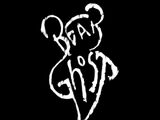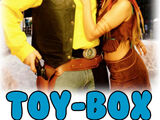Anarcho-punk is punk rock that promotes anarchism. The term anarcho-punk is sometimes applied exclusively to bands that were part of the original anarcho-punk movement in the United Kingdom in the late 1970s and early 1980s. Some use the term more broadly to refer to any punk or rock music with anarchist lyrical content, including crust punk, d-beat, folk punk, hardcore punk, garage punk or ska punk.
History[]

Crass in 1984. Crass played a major role in introducing anarchism to the punk subculture.
Before 1977[]
Some protopunk bands of the late 1960s had anarchist members, such as the German blues rock band Ton Steine Scherben and English bands connected to the UK underground, such as Hawkwind, Pink Fairies, The Deviants and the Edgar Broughton Band. These bands, along with Detroit's MC5, set a precedent for mixing radical politics with rock music, and established the idea of rock as agent of social and political change in the public consciousness. Other precursors to anarcho-punk include avant-garde art and political movements such as Fluxus, Dada, the Beat generation, England's angry young men (such as Joe Orton), the surrealism-inspired[Situationist International, the May 1968 uprising in Paris, and the CND. Jello Biafra of the Dead Kennedys has cited the Yippies as an influence on his activism and thinking.[1][2]
Post 1977[]
A surge of popular interest in anarchism occurred during the 1970s in the United Kingdom following the birth of punk rock, in particular the Situationist-influenced graphics of Sex Pistols artist Jamie Reid, as well as that band's first single, "Anarchy in the UK". However, while the early punk scene appropriated anarchist imagery mainly for its shock or comedy value or at best as a desire for hedonist personal freedom,[3][4] Crass along with neighbours Poison Girls may have been the first punk bands to expound serious anarchist ideas.[3] The concept (and aesthetics) of anarcho-punk was quickly picked up on by bands like Flux of Pink Indians, Subhumans, Chumbawamba and Conflict.[5] These first-wave anarcho-punk bands are musically varied but are often connected by discernible stylistic elements: a willingness to experiment that often went outside the bounds of other hardcore punk acts, a slipshod and improvised feeling, perhaps owing to the many of the bands conceiving of themselves more as musical collectives than formal acts, and "ranting" sections, where bands would expound on issues like animal rights or gender inequality.
As the 1980s progressed, two new punk styles evolved out of anarcho-punk: d-beat and crust punk. D-beat was a faster, more brutal form of punk music, and was created by bands like Discharge and the Varukers. Crust punk mixed anarcho-punk with an extreme metal sound, and was pioneered by bands such as Antisect, Sacrilege and Amebix. Somewhat later on in the 1980s, grindcore developed out of anarcho-punk. Similar to crust punk, but even more musically extreme, grindcore employed blast beats and incomprehensible death growls. Grindcore was pioneered by bands such as Napalm Death and Extreme Noise Terror. Parallel to the development of these sub-genres, many bands in the American hardcore punk scene adopted anarcho-punk ideology, including MDC and Reagan Youth.
Simultaneously, anarcho-punk began to fuse with elements of the new age travellers movement and neo-hippies, as well as the older political squatting scene. Consequently, elements of folk music, country, spoken word, traditional Irish music and jazz were being incorporated by diverse performers such as Annie Anxiety, and The Ex. By the end of the 1980s, the emerging rave culture had an influence on anarcho-punk, with travelling sound systems such as Spiral Tribe, and the Bedlam Sound System. Another related off-shoot is the UK traveller/crusty scene, with bands such as Back To The Planet and Radical Dance Faction playing reggae/dance-tinged punk.
By the 2000s, anarcho-punk had become more musically diverse than in the 1970s. In addition to previously established sub-genres. Examples might include the irreverent Bus Station Loonies, hardcore punk artists Propagandhi, new wave performers such as Honey Bane and folk punk bands such as Blackbird Raum. Some anarcho-punk bands incorporate indie rock such as the Nation of Ulysses, Blyth Power and The (International) Noise Conspiracy. Bands such as Axiom, Destroy and Disrupt have fused the grindcore and crust punk sounds. Digital hardcore often takes an anarchist stance in their lyrics, as typified by genre pioneers Atari Teenage Riot. Digital hardcore mixes punk (and sometimes rap) vocals with elements of many different genres, mainly hardcore techno, thrash metal, and noise music.
Ideology[]
While anarcho-punk bands have been often ideologically varied, most groups could be categorized has adhering to anarchism without adjectives, in that it embraces the syncretic fusion of many potentially differing ideological strains of anarchism. Some anarcho-punks identified with anarcha-feminists (e.g. Poison Girls), while others were anarcho-syndicalists (e.g. Exit-Stance). The Psalters are a folk punk band with an affiliation with Christian anarchism, though most anarcho-punk bands are generally critical of Christianity. Many anarcho-punks are supporters of issues such as animal rights, racial equality, anti-homophobia, feminism, environmentalism, worker's autonomy, the anti-war movement, and the anti-globalisation movement.
Anarcho-punks have criticized the perceived flaws of the punk movement and the wider youth culture in general. Bands like Crass and Dead Kennedys have written songs that attack corporate co-option of the punk subculture, people who are deemed to have sold out, and the violence between punks, skinheads, B-boys and other youth subcultures[5][6] and within punk itself. Some anarcho-punks are straight edge, claiming that alcohol, tobacco, drugs and promiscuity are instruments of oppression and are self-destructive because they cloud the mind and wear down a person's resistance to other types of oppression. Some also condemn the waste of land, water and resources necessary to grow crops to make alcohol, tobacco and drugs, forfeiting the potential to grow and manufacture food. Some may be straight edge for religious reasons, such as in the case of Christian, Muslim, Buddhist anarcho-punks (see Anarchism and religion for more background).
Although Crass initially espoused pacifism, this is not necessarily the case for all anarcho-punks. Despite the broader punk subculture's reactionary antagonism towards hippies, the ideals of the hippie counterculture were an influence on anarcho-punk. Crass were explicit regarding their associations with the hippie counterculture,[5][6] and this influence has also carried over to crust punk.
Direct action[]
Anarcho-punks universally believe in direct action, although the way in which this manifests itself varies greatly. Despite their differences in strategy, anarcho-punks often co-operate with each other. Many anarcho-punks are pacifists (e.g. Crass and Discharge) and therefore believe in using non-violent means of achieving their aims. These include peaceful protest, refusal of work, squatting, economic sabotage, dumpster diving, graffiti, culture jamming, ecotage, freeganism, boycotting, civil disobedience, hacktivism and subvertising. Some anarcho-punks believe that violence or property damage is an acceptable way of achieving social change (e.g. Conflict). This manifests itself as rioting, vandalism, wire cutting, hunt sabotage, participation in Animal Liberation Front- or Earth Liberation Front-style activities, and in extreme cases, bombings. Many anarchists dispute the applicability of the term "violence" to describe destruction of property, since they argue that destruction of property is done not to control an individual or institution but to take its control away.[7][8]
DIY punk ethic[]
Many anarcho-punk bands subscribe to a do-it-yourself ethic. A popular anarcho-punk slogan is "DIY not EMI", a conscious rejection of a major record company.[9][10][11] Many anarcho-punk bands were showcased on the Bullshit Detector series of LPs released by Crass Records and Resistance Productions between 1980 and 1994. Some anarcho-punk performers were part of the cassette culture. In this way, an attempt was made to bypass the traditional recording and distribution routes, with recordings often being made available in exchange for a blank tape and a self-addressed envelope. The anarcho-punk movement has its own network of fanzines or punk zines which disseminates news, ideas and artwork from the scene. These are DIY productions, tending to be produced in runs of hundreds at most. The zines are printed on photocopiers or duplicator machines, and distributed by hand at punk concerts, in radical bookstores and infoshops, and through the mail.
Musical style and aesthetics[]
Generally speaking anarcho-punk bands are often less focused on particular musical delivery and more on a totalized aesthetic that encompasses the entire creative process, from album and concert art, to political message, to the lifestyles of the band members themselves.[Citation needed] Crass listed as band members the people who did their album art and live visuals. The message is sometimes considered to be much more important than the music.[5][12] According to the punk aesthetic, one can express oneself and produce moving and serious works with limited means and technical ability.[12][13] It is not uncommon for anarcho-punk songs to lack the usual rock structure of verses and a chorus, however, there are exceptions to this. For example, later Chumbawamba songs were at the same time anarcho-punk and more pop oriented and had a pop song structure that made their message more accessible, even gaining chart hits in the process. In general the genre is stylistically diverse and is often more united by common goals and community bonds than particular sounds. One of the bands to take this to the extreme was Crass with their release Yes Sir, I Will, a raging and almost free-form improvised musical backing over which the lyrics are shouted. Examples of other highly experimental anarcho-punk acts might include The Cravats, Iceland's KUKL and the partially electronic act D&V.
See also[]
- Crust punk
- Punk ideologies
- List of anarcho-punk bands
- List of anarchist musicians
References[]
- ↑ Vander Molen, Jodi, Jello Biafra Interview, The Progressive (Feb. 2002)
- ↑ Colurso, Mary (2007-06-29) Jello Biafra can ruffle feathers, The Birmingham News
- ↑ 3.0 3.1 Dines, Mike. No Sir, I Won't: Reconsidering the Legacy of Crass and Anarcho-punk. Academia.edu. Retrieved on May 29, 2013.
- ↑ Savage, Jon (2002). England's Dreaming, Revised Edition: Anarchy, Sex Pistols, Punk Rock, and Beyond. St. Martin's Griffin. p. 204. ISBN 978-0312288228.
- ↑ 5.0 5.1 5.2 5.3 Berger, George (2006). The story of Crass. London: Omnibus Press. pp. 67–68. ISBN 1-84609-402-X.
- ↑ 6.0 6.1 ...In Which Crass Voluntarily Blow Their Own... CD booklet. http://www.southern.com/southern/label/CRC/
- ↑ César Chavez on the Pragmatics of Violence. Society for the Advancement of American Philosophy (SAAP). Retrieved on May 29, 2013.
- ↑ Fringe anarchists in middle of violent demonstrations. Seattle Post-Intelligencer. Retrieved on May 29, 2013.
- ↑ Maximum Rocknroll. 2004. pp. 14. http://books.google.com/?id=qFNbAAAAMAAJ&q=%22DIY+not+EMI%22&dq=%22DIY+not+EMI%22.
- ↑ Peace News for Nonviolent Revolution. 1985. p. liv. http://books.google.com/?id=FNREAQAAIAAJ&q=%22DIY+not+EMI%22&dq=%22DIY+not+EMI%22.
- ↑ DIY (not EMI) in 2010. Thee Faction. Retrieved on May 29, 2013.
- ↑ 12.0 12.1 allmusic quotation:
...its ideology of personal freedom (musical self-expression ought to be available to anyone, regardless of technical ability), and also that the message tended to be more important than the music.
- ↑ David Byrne, Jeremy Deller (2010) Audio Games, in Modern Painters, March 1, 2010 quotation:
I think I embrace a bit of the punk aesthetic that one can express oneself with two chords if that’s all you know, and likewise one can make a great film with limited means or skills or clothes or furniture. It’s just as moving and serious as works that employ great skill and craft sometimes. Granted, when you learn that third chord, or more, you don’t have to continue making "simple" things, unless you want to. Sometimes that’s a problem.
Bibliography[]
- Geoff Eley - "Do It Yourself Politics (DIY)", Forging Democracy: The History of the Left in Europe, 1850-2000, chapter 27: "The Center and the Margins: Decline or Renewal?." Oxford University Press, 2002. ISBN 0-19-504479-7 p. 476-481.
- Ian Glasper - The Day the Country Died: A History of Anarcho Punk 1980 to 1984 (Cherry Red publishing, 2006 ISBN 978-1-901447-70-5)
- Craig O'Hara - Philosophy of Punk: More Than Noise (AK Press, 1999 ISBN 978-1-873176-16-0)
- George Berger - The Story of Crass (London: Omnibus Press 2006, ISBN 1-84609-402-X)
External links[]
- Photographic archive of anarcho-punk bands
- A critical look at anarcho-punk Links to a series of articles and interviews on the subject.
- Crass Documentary Trailers & download
- Death To The World Orthodox Christian Punk 'Zine.
All items (2)







